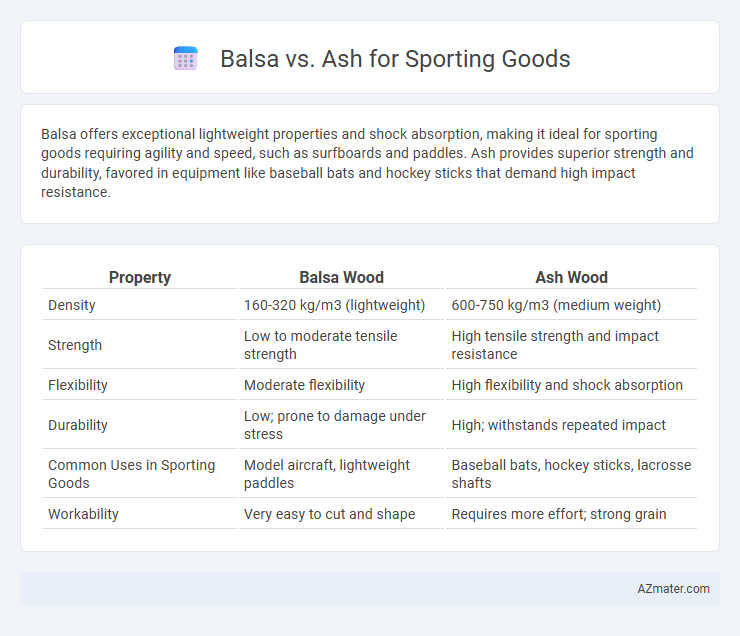Balsa offers exceptional lightweight properties and shock absorption, making it ideal for sporting goods requiring agility and speed, such as surfboards and paddles. Ash provides superior strength and durability, favored in equipment like baseball bats and hockey sticks that demand high impact resistance.
Table of Comparison
| Property | Balsa Wood | Ash Wood |
|---|---|---|
| Density | 160-320 kg/m3 (lightweight) | 600-750 kg/m3 (medium weight) |
| Strength | Low to moderate tensile strength | High tensile strength and impact resistance |
| Flexibility | Moderate flexibility | High flexibility and shock absorption |
| Durability | Low; prone to damage under stress | High; withstands repeated impact |
| Common Uses in Sporting Goods | Model aircraft, lightweight paddles | Baseball bats, hockey sticks, lacrosse shafts |
| Workability | Very easy to cut and shape | Requires more effort; strong grain |
Introduction: Balsa vs Ash in Sporting Goods
Balsa and ash woods are widely compared in sporting goods for their distinct properties and performance benefits. Balsa is favored for its exceptional lightweight characteristics and shock absorption, making it ideal for paddles and lightweight rackets. Ash offers superior strength and flexibility, commonly used in baseball bats and hockey sticks to deliver durability and power.
Material Overview: Characteristics of Balsa
Balsa wood is renowned for its exceptional lightweight properties, with a density ranging from 40 to 340 kg/m3, making it one of the lightest commercial woods available. Its cellular structure provides excellent buoyancy and shock absorption, critical factors for sporting goods such as surfboards, paddles, and skateboards. The wood's softness allows for easy shaping and sanding, ensuring customized performance and aerodynamics without compromising strength.
Material Overview: Properties of Ash
Ash wood is renowned for its exceptional strength-to-weight ratio, making it a preferred material for sporting goods requiring both durability and flexibility. Its straight grain and outstanding shock resistance provide enhanced impact absorption, ideal for baseball bats, hockey sticks, and canoe paddles. The material's hardness and wear resistance contribute to long-lasting performance, maintaining integrity under rigorous athletic use.
Weight Comparison: Balsa vs Ash
Balsa wood is significantly lighter than ash, with a density ranging from 0.1 to 0.2 g/cm3 compared to ash's 0.6 to 0.9 g/cm3, making balsa ideal for sporting goods requiring minimal weight such as lightweight paddles or rackets. Despite its low weight, balsa offers sufficient strength for certain applications but often lacks the durability and impact resistance of ash, which is preferred in items like baseball bats where toughness and shock absorption are critical. The weight advantage of balsa contributes to enhanced maneuverability and reduced fatigue during extended athletic performance.
Strength and Durability: Key Factors
Ash wood exhibits superior strength and durability compared to balsa, making it a preferred choice for sporting goods that require toughness, such as baseball bats and hockey sticks. Balsa, while much lighter, lacks the structural integrity for high-impact sports but excels in applications where minimal weight is critical, like model aircraft and lightweight paddles. The balance between strength and weight defines the suitability of ash and balsa in different sporting goods manufacturing.
Flexibility and Performance Differences
Balsa wood offers exceptional flexibility and lightweight properties, making it ideal for sporting goods that require quick responsiveness and shock absorption, such as surfboards and model aircraft. Ash wood, known for its strength and moderate flexibility, provides superior durability and impact resistance, often used in baseball bats and hockey sticks where sturdiness and controlled flex are crucial. The performance difference lies in balsa's ability to bend and rebound efficiently under stress, while ash balances flexibility with robust structural integrity for sustained power and control.
Applications in Popular Sporting Goods
Balsa and ash woods are prominent in sporting goods due to their unique properties; balsa's lightweight and high strength-to-weight ratio make it ideal for model aircraft, surfboards, and paddles where weight reduction is critical. Ash provides superior shock absorption and flexibility, commonly used in baseball bats, hockey sticks, and lacrosse shafts to enhance durability and performance. The choice between balsa and ash depends on the specific balance of weight, strength, and flexibility required in the sporting equipment.
Cost and Availability of Balsa and Ash
Balsa wood is typically more expensive and less readily available than ash, due to its lightweight properties and limited global supply, making it a premium choice for high-performance sporting goods like surfboards and lightweight paddles. Ash is more abundant and cost-effective, offering excellent strength and flexibility at a lower price, which suits budget-friendly sporting goods such as baseball bats and hockey sticks. The availability of ash wood is widespread across North America and Europe, whereas balsa primarily comes from South American regions, affecting their cost and supply stability in the sports goods industry.
Environmental Impact and Sustainability
Balsa wood, known for its lightweight and fast renewability, offers a lower carbon footprint compared to ash, which grows slower and requires more intensive harvesting practices, impacting its sustainability. Ash trees, often used for sporting goods like baseball bats, face challenges from overharvesting and pests like the emerald ash borer, threatening long-term availability and ecosystem health. Balsa's rapid growth cycle supports sustainable forestry practices, making it a preferred choice for environmentally conscious manufacturers in the sporting goods industry.
Choosing the Right Material for Your Sport
Balsa and ash wood offer distinct advantages for sporting goods, with balsa prized for its ultra-lightweight properties that enhance speed and maneuverability, making it ideal for equipment like racing paddles and lightweight skis. Ash provides superior strength, flexibility, and shock absorption, favored in items such as baseball bats and hockey sticks where durability and performance are crucial. Choosing the right material depends on the sport's specific demands for weight, strength, and impact resistance, ensuring optimal equipment performance and athlete comfort.

Infographic: Balsa vs Ash for Sporting Good
 azmater.com
azmater.com